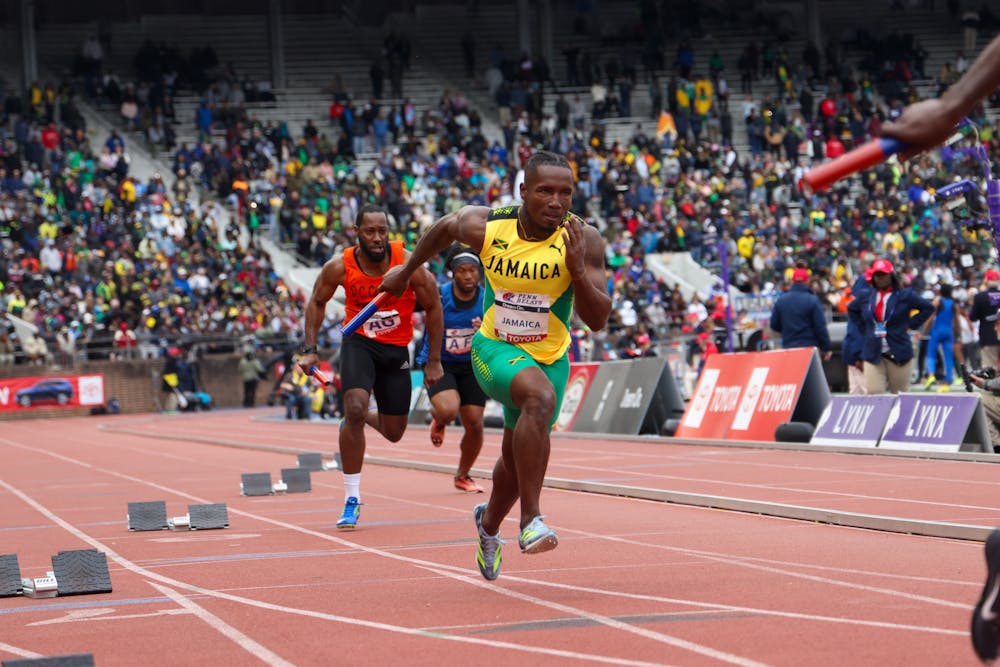
On the Rogers-O’Hern Lyons Oval/Track in Franklin Field, the brick wall below the bleachers is adorned with the gold and black plaques of the Penn Relay Carnival Wall of Fame. The newly recognized 2025 inductees include four individuals and two relay teams — one of which is the 1950 4x400-meter relay team from Morgan State, a historically Black university.
The 1950 relay team, comprised of Sam LaBeach, Bob Tyler, Bill Brown, and George Rhoden, set a new event record at Penn Relays, earning them Morgan State’s first victory at the event. The foursome’s dominance on the track garnered the HBCU’s team nationwide attention as they continued to break records at meets across the United States. According to the official induction site, Morgan State went on to win the 4x400m four more times over the next three decades. These four men put Morgan State on the map, setting the tone for Black track and field athletes from coast to coast.
Track and field meets have always built community, especially for Black spectators, athletes, and coaches. The Penn Relays are no different.
For nearly 130 years, the Penn Relays have transformed Franklin Field into a locus of community, competition, and culture. As the oldest and largest track and field competition in the country, the competition has brought together athletes from all walks of life, ranging from the youth of nearby Philadelphia middle schools to Olympian track and field idols.
The track is not the only area of the Penn Relays that feels electric. A festive atmosphere of cultural belonging and undeniable pride permeates in the stands, under each team’s tents, and even in the streets surrounding Franklin Field, upholding the Penn Relays’ 1910 given name of “Carnival.” Thunderous support from Penn Relays fans for Jamaican high schoolers and remarkable Black professional athletes is one of the numerous ways that the Black community has woven into the fabric of the event.
The spirit of Penn Relays has endured the tumultuous political climate of the United States throughout its rich history. While the nation battled racial segregation and injustice, the track shined brighter with resistance, perseverance, and pride for Black athletes. Notably, the Penn Relays have been open to Black athletes since their first race, but discriminatory turmoil attempted to force its way into the sport nonetheless.
Former Penn Relays Director Dave Johnson told Sports Illustrated in 2020 that he had come across an archival letter from the 1910s, which he described as “the most significant document [he] think[s] [he’s] ever seen regarding the Penn Relays.” This letter contained the remarks from a Penn Relays official to a university administrator who threatened to remove his team from the competition if African-American athletes were permitted to run.
One athlete who understands the impact of racial bias on the Penn Relays is Willis Nelson Cummings, a 1919 School of Dental Medicine graduate.
“Negroes were not allowed to participate in football or basketball or anything but track. … They didn’t take a picture of the 1918 track team because, with me as the captain, they would have a Negro sitting in the middle of the picture,” Cummings told The Daily Pennsylvanian in 1979. “They also threw out one of my varsity letters and didn’t mail me the other one until 1935.”
Nevertheless, excellence shone through the cracks. Cummings was the first Black captain of a varsity team at Penn — and in the Ivy League — and he graduated sixth in his class out of 259 students. His story, like so many others woven into the history of the Penn Relays, is a testament to the unyielding pursuit of greatness that Black athletes have carried through the test of time.
Another pioneer of this legacy was John Baxter Taylor, the first African American to win a gold medal at the Penn Relays. After being raised by formerly enslaved parents, Taylor attended the Wharton School for two years before transferring to the School of Veterinary Medicine in 1905. As an athlete, Taylor earned great acclaim on Penn’s track and field team.
His quarter-mile expertise garnered him recognition as one of the best in the collegiate world, and he traveled to the 1908 London Olympics following his graduation from Penn to compete in the 1,600m relay, earning Olympic gold with his teammates. Though he died months after his grand triumph, Taylor is a beacon of Black pride for Penn Athletics and an idol for many Black athletes today.
The Black community off the track complements the Black excellence on the track. The city of Philadelphia comes alive when the lights of Franklin Field beam. A vibrant party tradition has lingered for Black Penn Relays spectators, and every spring produces more lasting memories for attendees.
Parties in the city and on campus were the talk of the town, with people finding any way to show up and show out. High rise field — the field between Penn’s three high rise dormitories — was often pulsing with music, people, and connection for the Penn Relays festivities.
“If you did not make it to a party on the Friday of the Penn Relays, then it was a cabaret. … A University of Pennsylvania sponsored dance on campus, also on Friday evening, was attended by many Black Penn Relay partygoers,” Alonzo Kittrels, the director of administrative services at The Philadelphia Tribune, recalled of his Penn Relays experience as a college student. “We attended these affairs all dressed up and danced to the favorite dances of the times.”
Black greek life, also considered the Divine Nine historically Black sororities and fraternities, has been embedded in Penn Relays celebrations for decades. With the influx of Black spectators, alumni, and athletes that attend the Penn Relays year after year, Black sororities and fraternities became accustomed to hosting more social events at the time of the event to bring the Black community together through stepping, strolling, and saluting the Black experience. This year, the Intercultural Greek Council will be hosting the annual Penn Relays Triple “S” Show on April 26 in Irvine Auditorium.
At its heart, Penn Relays is a gathering place for worldwide Black communities. No group is more noteworthy than the Jamaican powerhouses whose gold, black, and green team colors proliferate in the crowd every April. Their pride is represented by their roaring cheers, rhythmic music, and the overall boisterous, joyful energy that pervades Franklin Field — hence, their flag was the first foreign flag to be flown at Franklin Field.
According to Team Jamaica Bickle, the leading organization for support services to Caribbean athletes, “ESPN estimates that … approximately 50%” of Penn Relays spectators each year “are Jamaicans/Caribbean nationals. Others estimate the number is closer to 70%.”
The support for Jamaicans is deserved. Since Jamaican high schools were first introduced to the Penn Relays in 1964, their dominance has seized track enthusiasts’ attention. Jamaican athletes, including eight-time Olympic gold medalist Usain Bolt and Olympic medalist Roneisha McGregor, have been crowd favorites that greatly influence the renown of the Penn Relays.
Black excellence is far from waning, especially among Penn track and field’s current athletes looking to compete at this year’s Penn Relays. This season in particular has been nothing short of a celebration of Black success. At the 2025 Ivy League Indoor Heptagonal Championships, Black Penn athletes earned three gold medals, one silver medal, and two program records.
“As a Black athlete, being able to cultivate a community for traveling Black athletes [from around the world], to enjoy Philly with them … is one of my favorite parts of Penn Relays,” star junior thrower Angeludi Asaah said.
“We are planning this year to be able to invite [collegiate] athletes from all schools … to come, after they compete on Saturday, and kind of … celebrate in fellowship with them because it is a big opportunity to be able to compete [at Penn Relays],” she added.
The Daily Pennsylvanian is an independent, student-run newspaper. Please consider making a donation to support the coverage that shapes the University. Your generosity ensures a future of strong journalism at Penn.
Donate







